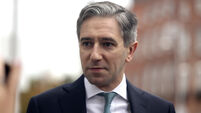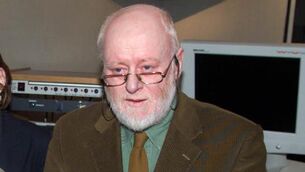Inside Russia's conspiracy theory factory
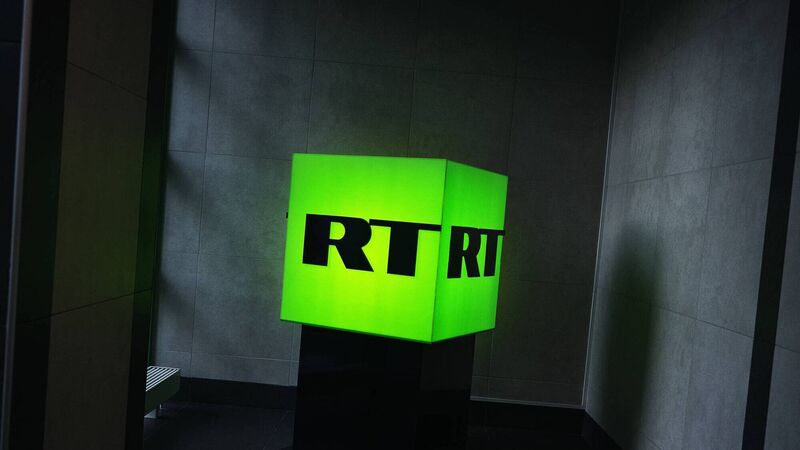
The EU banned RT shortly after the Ukraine invasion began in late February, in response to what it said was a Russian campaign of “disinformation, information manipulation and distortion of facts”. Photo: Misha Friedman/Getty Images
It’s the middle of the day in Moscow, and RT, the Kremlin’s 24-hour English-language news channel, is racing through a dizzying line-up.
Ukrainian soldiers are abandoning their positions in the besieged Azovstal steel plant, which RT bills as a fatal blow to Kyiv’s war effort. There’s the cautionary story of a British volunteer with the Ukrainian army, who says he was duped.
A meeting of G7 foreign ministers prompts a report on the West’s hypocrisy in condemning Russia’s military operations but not Israel’s. News segments are interspersed with bombastic talk shows and mini documentaries such as Fast Forward to Fascism, an exposé on neo-Nazis in Ukraine.
Watching RT from the scarred outskirts of Kyiv, British reporter Sara Firth was struck by just how fully the network appeared to have embraced an alternate reality.
In one broadcast, star RT correspondent Maria Finoshina lamented the demolition of bridges and other infrastructure by Ukrainian troops, without mentioning why they were blowing them up: to slow advancing Russian forces. “It’s still so hard to wrap my head around,” Firth says.
And yet for a substantial chunk of RT’s history, Firth, who joined as an on-air correspondent in 2009, was among the many young Britons, Australians, and other foreigners who worked for the network, providing an international veneer to one of President Vladimir Putin’s main propaganda platforms.
Carefully oriented to the preferences of the social media age, RT evolved into an important tool by the time Russia invaded Ukraine.
Its direct viewership was always modest. But disruptive conspiracy theories pushed by its hosts (including questioning official accounts of the 9/11 attacks and claiming the Ukrainian government was riddled with Nazis) energised political fringes in Europe and North America.
It appealed equally to partisans of the right and left, united by their skepticism of establishment politics.
In 2015, Mike Flynn, the former US general who would later be named as Donald Trump’s national security adviser, flew to Moscow for RT’s 10th anniversary gala, where he was seated next to Putin as an honored guest. Right across the table was Jill Stein, the Green Party US presidential candidate, breaking bread with Putin’s chief spokesman.
The EU banned RT shortly after the Ukraine invasion began in late February, in response to what it said was a Russian campaign of “disinformation, information manipulation and distortion of facts”. The UK soon followed suit, while US TV carriers cancelled its distribution deals.
YouTube, vital for amplifying its videos, suspended RT’s accounts, citing a policy to prohibit “content denying, minimising, or trivialising well-documented violent events.” Still, RT remains alive and well, serving Russia’s effort to muddy the picture of what’s really going on in Ukraine.
Channelling Putin’s Russian propaganda
In particular, it’s become a key part of the Kremlin’s strategy to blunt the impact of sanctions by winning friends in Africa, Asia, and Latin America, places where news is consumed primarily through social media and most governments have no particular animus toward Putin.
At the same time, RT is helping to spread stories through a broad ecosystem of Russian-backed outfits such as the news agency, Sputnik, and video provider, Ruptly.
And it continues to inspire other efforts to break the dominance of traditional news organisations, whether it’s China’s attempts to refine outward-facing propaganda or projects such as TalkTV, a British channel financed by Rupert Murdoch promising “straight talking” on hot-button issues.
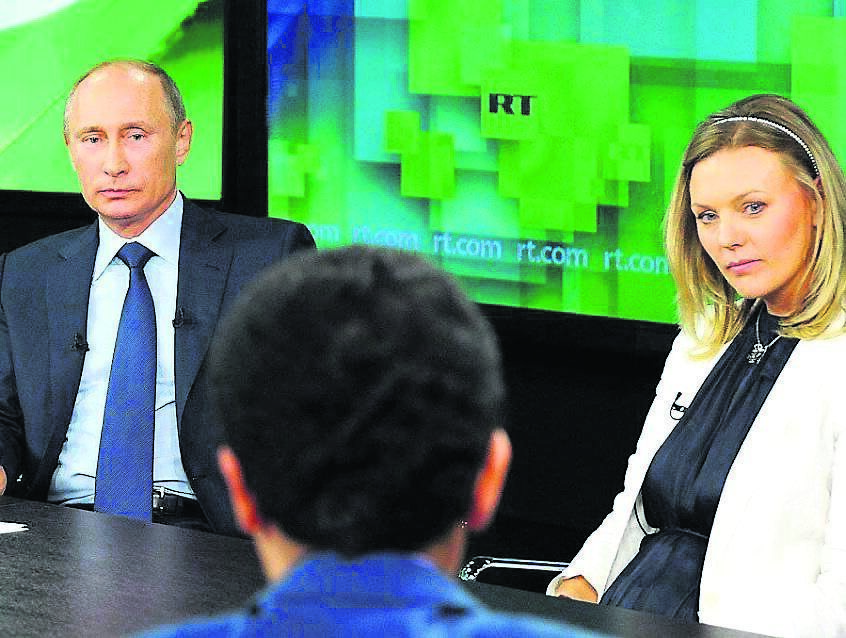
RT, which is funded by the Russian state, says it makes its own editorial and operational decisions, and in 2013 Putin described it as “absolutely independent,” even if it “cannot help but reflect the Russian government’s official position” on key issues.
In a response to questions, Deputy Editor-in-Chief Anna Belkina wrote that the network’s priorities haven’t changed as a result of the war and that its goal is to highlight “stories, views and voices overlooked by the mainstream media yet wanted by an audience of many millions”.
As the confrontation between Russia and the West intensifies, understanding RT and its influence has never mattered more.
“We knew what was going on,” said Firth, who left RT in 2014. “What I had for a very long time thought I could avert my eyes from, became something extremely dangerous.”
Troubled beginnings
Initially called Russia Today, RT was created in 2005 by Putin adviser Mikhail Lesin and his colleague Alexei Gromov, a former diplomat who ran the Kremlin press office.
After Putin’s election five years earlier, Lesin, then serving as media minister, had overseen the consolidation of Russia’s domestic TV channels into the hands of the State, a bare-knuckle process involving considerable intimidation of private-sector media owners.
International audiences were the next frontier. It was time, Putin would later say, to “break the monopoly of Anglo-Saxon mass media”.
To run RT, Lesin and Gromov chose a young, Kremlin-sympathetic reporter, Margarita Simonyan, whom Gromov had come to know while she reported on the president. The team soon placed an ad in The Guardian’s media supplement, seeking applicants for a “new English-language channel,” without providing details.
Ahron Young, an Australian who was one of the first recruits, recalls being summoned to a North London office to audition as an anchor. When he and other applicants asked who was funding the network, they were sometimes told a group of businessmen had started it for tax reasons or simply to “go and find out” for themselves.
Most didn’t mind the mystery. RT seemed to be offering real, paying opportunities, and moving to Moscow sounded like an adventure. Within a few weeks, Young and dozens of other international hires were on a plane. When they arrived, several former employees recalled, they found chaos.
Nothing seemed to work properly at RT’s makeshift studios in the offices of state news wire RIA Novosti. Chairs collapsed; cumbersome video-editing software crashed.
RT’s official debut in December 2005 was disrupted by technical difficulties that executives blamed on a cyberattack. Staffers thought the more likely problem was equipment seizing up as temperatures plunged.
Arriving at a successful editorial strategy proved more difficult than fixing rickety gear. In its first few years, RT operated on Soviet principles, largely ignoring what its audience might want.
Most stories focused on Russia and its neighbours, alternating coverage of set-piece events, speeches, anniversaries, and so on, with tales of military and technological prowess. For light interludes, there were gauzy nature or culture reports.
News channels typically vary their line-up through the day, but RT’s rotation went unchanged for long stretches.
Serge Cartwright, a journalist who worked in the Moscow headquarters, wrote a play based on his experience that included a running joke about a repeated segment on craftsmen in Russia’s far east: “Furry Russian boots every hour or every other hour?” a producer asks.
Turning point
In the early days, RT’s coverage was often relatively straight. But on issues dearer to Moscow, everyone was expected to toe the line.
In 2007, the government of Estonia enraged the Kremlin by relocating the Bronze Soldier, a statue of a Red Army serviceman that many Estonians viewed as a symbol of Soviet oppression. In a broadcast on the incident, Cartwright described Estonia as having been previously “occupied” by the Soviet Union.
Immediately, a Russian senior editor called Cartwright and his team into a meeting, delivering a stern reprimand. Estonia wasn’t occupied, the editor said. It was “absorbed”. Belkina says she isn’t aware of the episode.
Meanwhile, geopolitical tensions were rising. Russia’s 2008 war with Georgia, run by a pro-European government that was seeking NATO membership, marked a turning point.
Although Russia prevailed militarily, Putin’s government saw the conflict as a public-relations failure, with Western politicians clamouring to declare their support for the Georgians.
That frustration prompted a dramatic change at RT. It was rebranded to be less visibly Russian, with Russia Today dropped in favor of the acronym by which it’s been known since.
There was also a boost in funding and a shift in philosophy, guided by what might be RT’s central insight: Kremlin policy might be best served, not by making Russia look good, but by making the rest of the world look worse. (Belkina says the overhaul occurred because, “audiences most strongly responded”, to stories about international events.)
'Question More'
RT’s new slogan, courtesy of the advertising giant, McCann, was ‘Question More’, which its anchors interpreted as an instruction to interrogate the most basic assumptions of international politics.
In the UK, billboards advertising the channel superimposed images of Barack Obama and Iranian President Mahmoud Ahmadinejad, asking, “Who Poses the Greatest Nuclear Threat?”
Then, in September 2011, Putin signalled he was returning to the Russian presidency after a stint as prime minister, prompting protests that were harshly suppressed by security forces, a portent of further repression to come.
RT cranked out ever-more-outlandish stories, particularly through its Washington-based US arm, which began operations in 2010. A show called The Truthseeker claimed that reports of chemical weapons use by Bashar al-Assad, the Russian-backed Syrian dictator, were a BBC hoax.
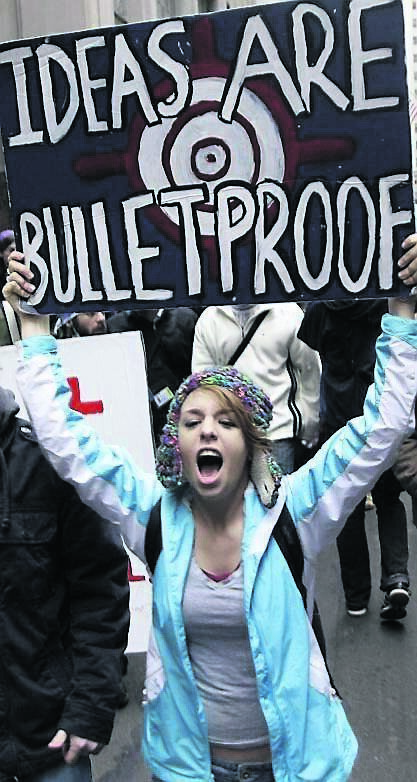
RT gave wall-to-wall coverage to the Occupy Wall Street movement, using it as an opportunity to emphasise economic inequality.
Although some content appeared mainstream (RT America carried Larry King Now, a talk show hosted by the former CNN personality), more typical of the overall tone was The World Tomorrow, an interview series fronted by Julian Assange. His first guest was Hassan Nasrallah, the leader of Hezbollah.
“The pitches became extremely crazy,” Firth says of the period following Putin’s return. “There was no pretense anymore.”
Through all this, it was unclear how much of an audience RT really reached. In the UK it claimed as many as 2.4m viewers in 2011, though the network has never reported viewership in a consistent or audited manner, and other data sources cite smaller figures.
Today its website describes RT as “available to” about 700m people in more than 100 countries, a number it doesn’t seem to have adjusted since the Ukraine invasion, but makes no claims about how many are actually watching.
Belkina, the RT editor, says such figures are based on “a large-scale set of research”. Nonetheless, its benefactors appeared to believe RT was making a difference.
In 2013, it moved into a spacious new head office, and by 2015 its budget was just under 14bn rubles, about €220m at the time.
RT’s approach to news came into its own with the downing over Ukraine of MH17, a Malaysian airliner traveling from Amsterdam to Kuala Lumpur.
RT proposed endless potential explanations, claiming, among other things, that Ukrainian forces intending to hit Putin’s presidential jet might have struck the Boeing 777, or that Ukrainian warplanes had been seen nearby, citing evidence from an air traffic controller identified as “Carlos”. (His testimony was later debunked as a fraud.)
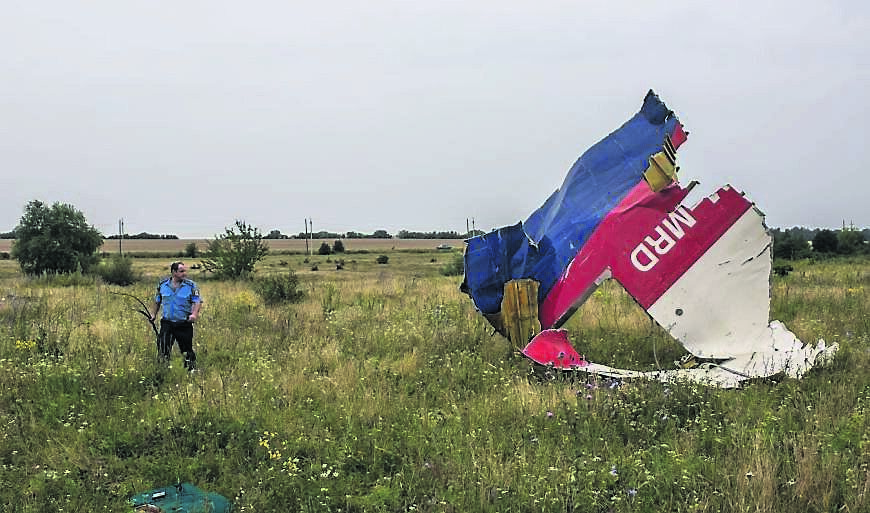
The only thing RT’s anchors claimed to be sure of was that the facts were unknowable.
In reality, a multinational investigation concluded that MH17 was destroyed by a Russian-operated missile, fired from territory held by Kremlin-backed rebels.
By then, Firth had relocated to the London bureau. She watched the MH17 coverage with dismay.
“It was a very overwhelming moment to watch what RT was putting out there,” she recalls.
The same day the airliner was shot down, Firth had tickets for a theatrical adaptation of George Orwell’s 1984, which felt like a warning too obvious to ignore. She announced her resignation on Twitter the next morning.
“I have huge respect for many in the team, but I’m for the truth,” she wrote. RT responded with a statement of its own: “Apparently we have different definitions of the truth,” it said.
RT breaks America
Two months before the 2016 US presidential election, RT America trumpeted its biggest coup: a King interview with Trump. “We did it!” tweeted Simonyan, the editor-in-chief.
In response to subsequent criticism, Trump’s aides claimed unconvincingly that they thought the interview was going to air on King’s podcast, not RT.
Trump’s appearance nonetheless signalled a new era for the network. It would be wrong to say it had arrived, because an arrival follows a journey to a new location.
What had actually happened was that a significant part of the US political world had converged on RT’s pre-existing perspective: treating every institution, and the notion of the truth itself, as suspect.
By the time Trump was elected, RT’s stories and narratives were being recirculated by sites such as Infowars.com and amplified by conservative voices on social media. RT returned the favour, enthusiastically covering conspiracy theories originating in the internet’s far-right fever swamps.
In some respects, it was even better suited to the Trump era than Fox News. Like Trump, RT was bound by no fixed principles and animated by an exaggerated sense of moral relativism.
In another interview, with Bill O’Reilly on Fox, Trump expressed a view that matched RT’s editorial style exactly. Asked why he respected Putin, whom O’Reilly called “a killer,” Trump responded, “We’ve got a lot of killers. What, you think our country is so innocent?”
Over the next few years, RT found ample opportunities to highlight what it portrayed as the hypocrisy of the West. The gilet jaune protests in France, which began in 2018 when motorists angry about fuel taxes started occupying suburban roundabouts, were almost perfect for the network, expressing no real political agenda but plenty of anti-establishment anger.
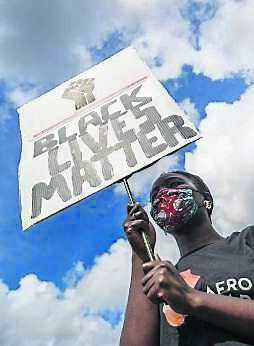
According to analysis cited by French researcher Maxime Audinet, RT France put out 1,034 videos about the demonstrations, which were viewed 30 million times; 25% more than the 629 videos produced by five of the country’s major online media outlets.
The Black Lives Matter demonstrations in 2020 and the combustive atmosphere of the run-up to the US presidential election provided even richer sources of controversy. RT focused on the most unruly protests, creating an impression of generalised chaos.
But the channel and its social media affiliates also gleefully promoted stories about police brutality against Black people. Then they pivoted seamlessly to airing Trump-friendly claims that the election was both dysfunctional and fraudulent, emphasised with knowing asides.
“You gotta be kidding me,” Simonyan tweeted after the Organisation for Security and Co-operation in Europe, an intergovernmental body that monitors elections, described the US race as well-managed.
RT and Ukraine
At the outset of Russia’s military build-up on Ukraine’s borders, RT followed a familiar playbook. While analysts everywhere questioned the likelihood of an actual attack, it went further, ridiculing warnings of war as hysterical.
The full-scale invasion that began on February 24 shattered that illusion; it turned out the truth was knowable, and the US and its allies had been right about it.
RT swung rapidly to endorsing the Kremlin’s preferred narrative: that its forces were engaged in a “special military operation” defending ethnic Russians, not an aggressive war. It then adapted its traditional strategy of looking for ways to undercut mainstream narratives, claiming Ukraine’s leaders were authoritarian nationalists, if not full-blown Nazis, whose people needed urgent liberation.
The dissonance was too much for many of RT’s remaining foreign staff. Dozens resigned.
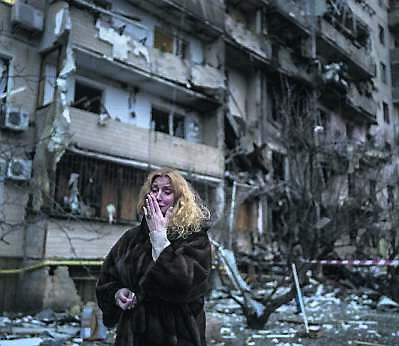
“I genuinely didn’t believe Russia would launch a full-scale military attack on Ukraine,” tweeted Bryan MacDonald, an online RT journalist and one of its most prominent defenders. He’s since been sanctioned by the UK government.
"I thought it was sabre-rattling or a bluff to force the West’s hand in negotiations. I apologise for getting it so badly wrong."
Heavily restricted by government bans and decisions by YouTube and other platforms to block its content, RT is now difficult for Americans and Europeans to access.
The situation is different in poorer countries, where it remains freely available and widely promoted, especially on social media. That’s partly a function of many governments’ ambivalence about how to respond to the war in Ukraine.
RT in the developing world
Few leaders of developing nations support Putin’s actions, but historical and defense ties, plus skepticism about Western intentions, mean many aren’t ready to isolate Moscow.
Most countries in Asia, for example, have declined to implement economic sanctions on Russia, allowing trade to continue.
At a recent security summit in Singapore, Indonesia’s defense minister reminded attendees that “your enemy is not necessarily my enemy,” emphasising that his country, the world’s fourth-most populous, considers itself neutral.
In turn, RT has been doubling down on efforts to reach emerging-market audiences, who will help decide just how cut off from international commerce Russia is likely to remain. These efforts span the globe.
The channel has broadcast in Arabic since 2007 and has been building up French-language coverage in Africa. It’s also planning a new English hub in Johannesburg. The continent is increasingly a foreign policy priority for Russia; in late July, Minister of Foreign Affairs Sergei Lavrov visited Egypt, Ethiopia, Uganda, and the Republic of Congo, holding amicable meetings with leaders in each country.
RT has arguably been most successful in Latin America, where many countries have a long history of skepticism toward the US. RT’s Spanish Facebook page has about 17m followers, more than twice the total for its English equivalent, with particularly large numbers in Argentina, Mexico, and Venezuela.
However, there’s long been a risk of exaggerating RT’s power, particularly in developed countries with strong incumbent media organisations.
According to data published by Rasmus Kleis Nielsen, the director of the Reuters Institute, only 0.6% of the UK’s online population viewed RT’s content in early 2022, compared with almost 44% for The Guardian or the BBC, for example.
Engagement is often limited and probably inflated by bots. But the number of genuine viewers is likely to be much higher in emerging markets where there’s less skepticism of Russia and heavier reliance on news from social media.
Most important, RT’s model, and Russia’s strategy for fighting attempts to strangle its economy, don’t require the Kremlin to convince anyone of much.
It may be enough to sow doubt, about both what’s really happening in Ukraine and the legitimacy of the governments trying to punish Russia for it.
And sowing doubt is, after all, RT’s speciality.
- Bloomberg

Unlimited access. Half the price.
Try unlimited access from only €1.50 a week
Already a subscriber? Sign in
CONNECT WITH US TODAY
Be the first to know the latest news and updates




